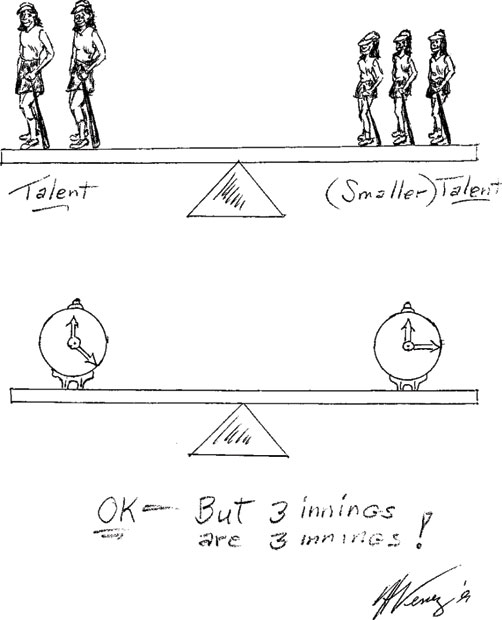
CHAPTER
16
Balancing the playing time is critical. Any kids sports organization must give serious thought to the rules on this crucial subject. Use pertinent criteria such as defensive and or offensive plays; innings, periods, at bats; minutes of playing time; or combinations of these or other criteria.
If the teams are made up of two age groups, should the rule be the same for first-year and second-year kids? The kids who stick with the program for a second year will likely get more playing time in the second year just because they have matured and probably improved. Do we expect approximately equal time? Can the method be easily measured by the team scorekeeper? Consider how to monitor the results – honor system, turn-in timesheets, and having a league official attend random games. Also consider how you will you handle disputes between coaches.
Nothing can sour kids and parents more than the perception that they are being “cheated” on playing time. Establishment of minimum playing-time rules will go a long way toward keeping all parents and kids happy without destroying the competition. This is also a giant step toward “parity.”
Whatever rules are developed should, in my opinion, be for both the regular season and for playoffs. Changing rules for the playoffs sends a poor message to coaches, players, and parents: During the regular season, we were interested in parity; now we are interested in winning at all costs.
Some say that “competitive leagues shouldn’t have such rules.” I disagree. At these young ages, even competitive leagues should guarantee a minimum amount of playing time, though the competitive league can have different playing-time rules than the general league.
After all, according to one study, less than one in 100 kids playing sports will play college sports. Less than four percent of college players ever play pro sports. So put playing time into perspective.
At these young ages, kids shouldn’t be pushed into a particular sport or pushed to play entire games, or be made a pawn in the process. Many studies have proved that playing time at very young ages makes no difference in the players’ ability to excel at older ages. I contend that how much fun young kids have is far more important to their progress than their playing time. If they learn to enjoy the game, they will have a much greater chance of excelling at it.
Balancing the playing time is the first step toward parity in the league.
You can achieve parity by balancing the talent and balancing the playing time. These drawings illustrate that. Maybe a third sketch can be added to the drawing – one that shows an adult coach keeping a kid (littler than the other kids) from falling off the balance beam.
